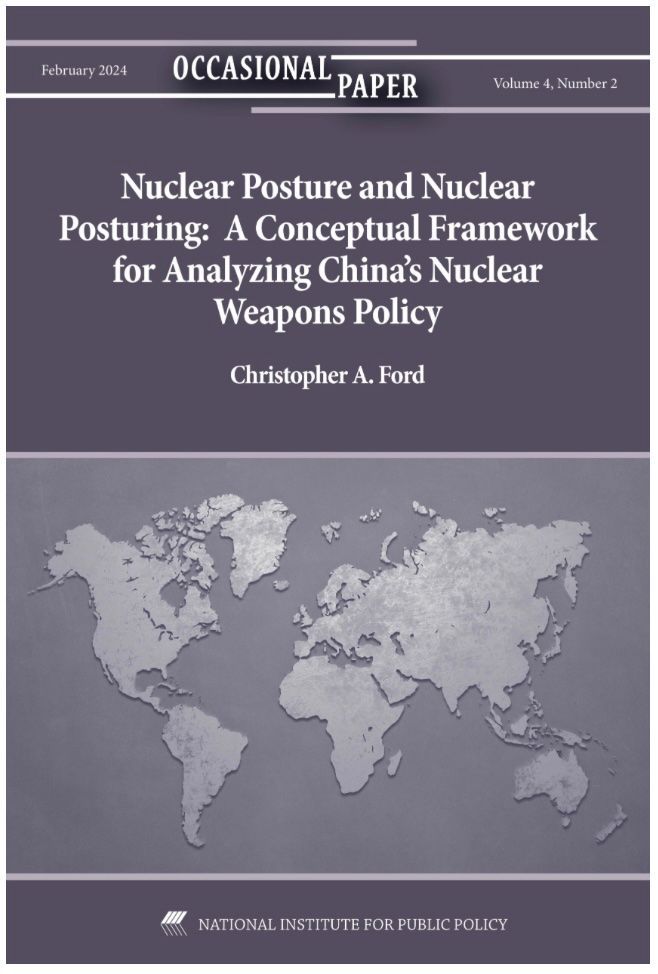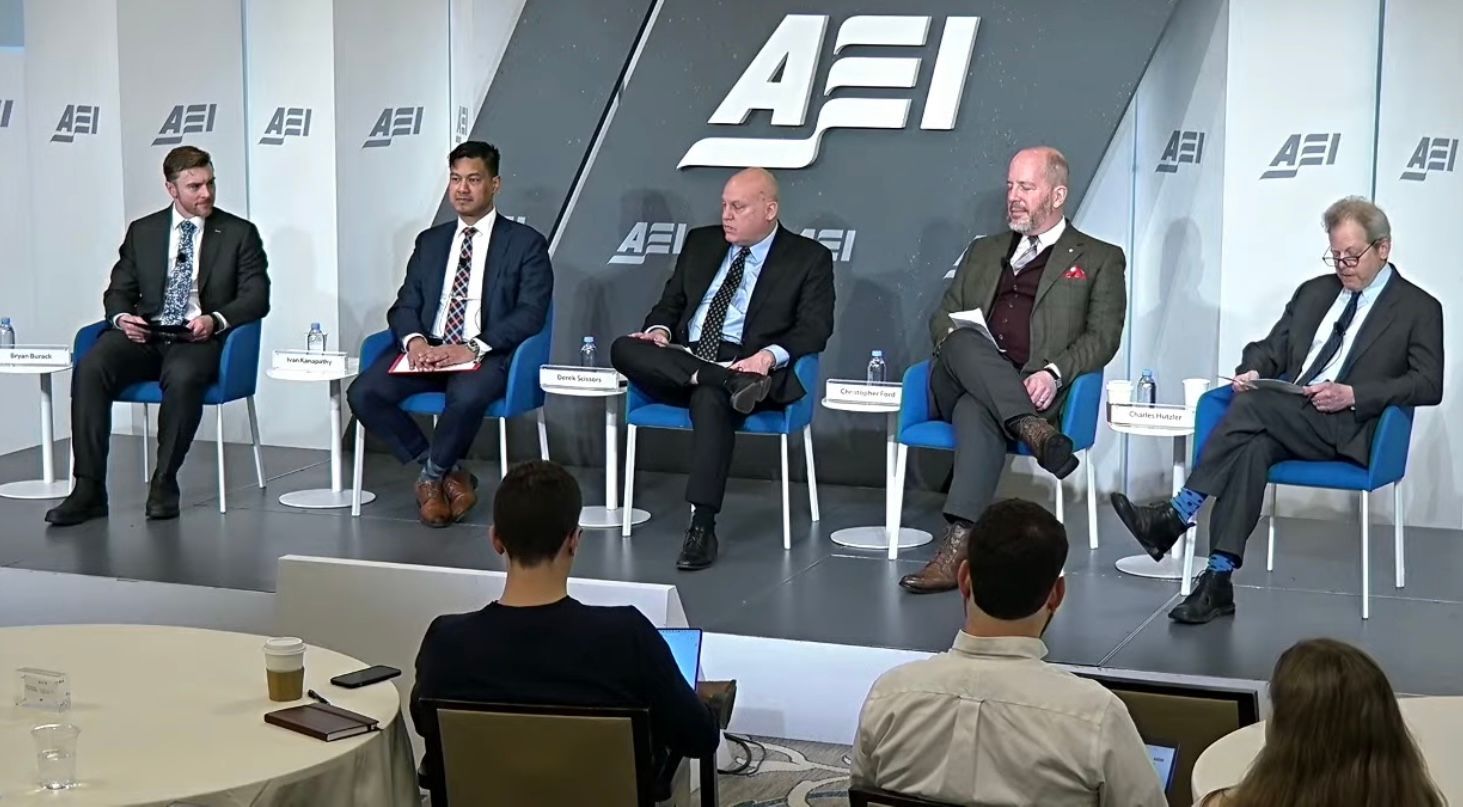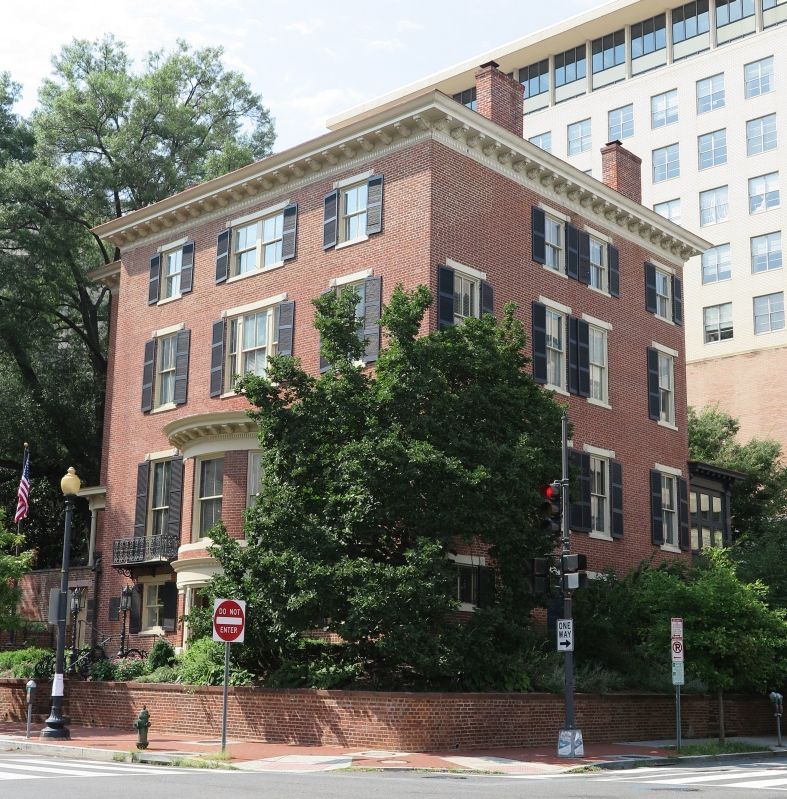The Hon. Christopher A. Ford
New Paradigms Forum -- International Security Policy Since 2009
Controlling Nuclear Materials Worldwide
In his speech on nuclear disarmament in Prague’s Hradcany Square last spring, President Barack Obama announced what he said was “ a new international effort to secure all vulnerable nuclear material around the world within four years.” Expanding upon this theme, the president declared that
“ We will set new standards, expand our cooperation with Russia, pursue new partnerships to lock down these sensitive materials. We must also build on our efforts to break up black markets, detect and intercept materials in transit, and use financial tools to disrupt this dangerous trade. Because this threat will be lasting, we should come together to turn efforts such as the Proliferation Security Initiative and the Global Initiative to Combat Nuclear Terrorism into durable international institutions. And we should start by having a Global Summit on Nuclear Security that the United States will host within the next year.”
Of the various arms control- and disarmament-related initiatives the President advocated in Prague, this particular priority has perhaps been the one that has elicited the broadest support across the U.S. political spectrum. And well it should. Whether or not one believes that nuclear-armed terrorism is the most significant threat faced by the United States – and opinions differ on that score – it seems unquestionably to be a serious one.
Given the possibility that poorly-secured nuclear materials might end up in the hands of emerging proliferator governments, moreover, a secure-the-materials push is also an essential component of global nonproliferation policy. The U.S. Intelligence Community, for instance, has publicly assessed that Iran “probably has imported at least some weapons-usable fissile material,” though so far most likely “not … enough for a nuclear weapon.” I recognize that such transfers do not necessarily occur solely by accident: we need to worry about deliberate proliferation in addition to theft or loss. Nevertheless, bloody-minded non-state actors do seek such materials, and the world clearly leaves them lying around at its grave peril. We should applaud President Obama’s determination to improve global nuclear materials security.
For the most part, the only actual criticism of this policy of which I am aware has been to question the Administration’s seriousness – All nuclear material? Everywhere? By April 5, 2013? Really? – rather than its objective of improving nuclear materials security. This basic aim is quite sound, and our president’s speedy success in this endeavor is to be encouraged.
Ambassador Bonnie Jenkins – whom I know from years past as a sharp arms control lawyer, fellow Navy Reserve officer, and very pleasant person, and who is now the U.S. Coordinator for Threat Reduction Programs – recently gave a speech in London outlining the Administration’s plans for securing nuclear materials. Her speech is worth a look, for it probably provides the best window to date upon current U.S. Government thinking.
In a Washington political environment in which it seems almost impossibly hard for the parties to cooperate across the aisle, the Administration’s nuclear materials security policy should be seen as something of a bright light. For while present-day officials seem uncomfortable admitting this, the Obama effort represents a continuation of George W. Bush’s policy – and indeed that of Bill Clinton before him. This is, quite properly, a genuinely bipartisan issue. Let’s take a closer look.
As evidenced by Amb. Jenkins’ remarks, the Obama Administration would like people to see the present effort as a logical evolution building upon Clinton-era policies. She stresses that it grows out of the Nunn-Lugar Cooperative Threat Reduction (CTR) program originally created in 1992. In order to make Obama’s spin on CTR seem novel and interesting – change we can believe in! – Jenkins’ comments revolve around the need to update this approach from 1990s-era priorities by expanding it “beyond the Former Soviet Union” (FSU) in order to make it a genuinely global initiative and finally to transcend the narrow “geographically-specific threats that served as the basis for the creation of the CTR program in the 1990s.”
The Administration’s characteristic eagerness to slight Bush Administration contributions to international security, however, shouldn’t be permitted to obscure the real bipartisanship of nuclear materials policy, or the degree to which the globalization of CTR has actually been underway for years. The “geographically-specific” FSU-centric focus of U.S. Government nuclear materials control policies, in fact, was transcended years ago.
Indeed, with the exception of the high-publicity “summit” President Obama plans soon to host on the subject, essentially all of the specific policy initiatives flagged by Amb. Jenkins in her recent remarks on the Obama Administration’s nuclear materials policy are efforts that began under previous administrations. She is right that the Global Partnership Against the Spread of Weapons and Materials of Mass Destruction – launched by President Bush and his counterparts at the 2002 G-8 Summit in Kananaskis, Canada – was initially limited to cooperation projects in Russia and the Ukraine to address nonproliferation, disarmament, counterterrorism, and nuclear safety issues. To suggest that the U.S. Government did not subsequently broaden its various materials-control and nuclear terrorism-prevention programs to encompass the world beyond the FSU, however, is quite misleading.
President Bush made this change in emphasis quite clear as early as his second State of the Union address in January 2003. There, he proclaimed that the United States was “strongly supporting” efforts ( e.g. , by the International Atomic Energy Agency) to “track and control nuclear materials around the world,” and announced that his Administration was “working with other governments to secure nuclear materials” not merely “in the former Soviet Union” but in fact also “to strengthen global treaties banning the production and shipment of missile technologies and weapons of mass destruction.”
(One should not, of course, assume that work to secure nuclear materials in Russia and other countries of the FSU stopped – or that further work was not still needed. By 2003 alone, U.S. efforts to improve the security of materials worldwide had included securing an additional 35 tons of material in Russia, working out a “breakthrough” in giving U.S. officials access to Russian warhead storage sites, and in removing highly enriched uranium from a Romanian reactor. The United States also helped Uzbekistan secure problematic nuclear materials in 2006, for example.)
This Bush Administration’s refocusing from the FSU to the rest of the world produced a number of notable initiatives, which President Obama has himself flagged as high priorities – though, ungenerously, without acknowledging that his predecessor was responsible for creating any of them. As we have seen, in his Prague speech, Obama highlighted the Proliferation Security Initiative (PSI) and the Global Initiative to Combat Nuclear Terrorism (GICNT) as critical tools in this regard. Yet these were Bush initiatives designed precisely to address nuclear and other weapons of mass destruction (WMD) materials threats on a global basis.
PSI was launched by President Bush in 2003 with the aim of building multinational cooperation in the interdiction of WMD-related transfers. Originally with 11 participants, PSI has subsequently mushroomed, and many interdiction exercises have been carried out around the world. Long a truly “global” effort, PSI currently involves some 80 countries, and the number is “ steadily increasing.”
GICNT – founded precisely in order to go beyond PSI-style interdiction of trafficking to critical issues of “ material protection, detection, law enforcement, emergency response, consequence management, attribution and criminal justice ” – was founded by President Bush and Russian President Vladimir Putin in 2006, but quickly grew to include the other G-8 members (Canada, France, Germany, Italy, Japan, and the United Kingdom) and then many additional countries. By June 2008, 73 countries had become GICNT “partner nations,” including all five NPT nuclear weapons states, other states that have declared possession or are suspected of possessing nuclear weapons (India, Israel, and Pakistan), all EU members, and most countries possessing advanced civil nuclear energy. GICNT was designed to enhance security of civilian nuclear facilities, improve nuclear materials accounting and control, improve detection and regulation of nuclear materials, improve nuclear-related consequence management in the event of a nuclear-related terrorist attack. There was nothing FSU-centric about this effort whatsoever, of course: the Bush Administration and its diplomatic partners were engaged in efforts that were emphatically “global” right from the start. President Obama’s re-endorsement of GICNT – in a joint statement with President Medvedev in 2009 – is welcome, but certainly wasn’t a new U.S. position.
In her list of steps the Obama Administration is using to control nuclear materials, Jenkins also offers the Nuclear Trafficking Response Group (NTRG). She describes it as an example of how the U.S. Government is now placing “particular … emphasis” upon combating nuclear smuggling. NTRG, however, was founded in 1995. Jenkins also discusses the importance of nuclear forensics in anti-smuggling operations, and touts the Nuclear Smuggling Outreach Initiative (NSOI) as an example of how “we are placing an emphasis” on fighting nuclear smuggling. A “Prevention of Nuclear Smuggling Group” (PNSG) was established within the NTRG framework under President Bush in 2007, however, and NSOI itself long predates the Obama Administration. ( Kyrgyzstan joined NSOI in 2007 , for instance.) Jenkins’ “we” should thus be read more broadly than one might think from reading her remarks.
What about the Export Control and Related Border Security (EXBS) programs that Jenkins properly lauds as being “now active on five continents”? (Note the “now.”) She’s right that it is active on a global basis; but a bit less clear in letting her audience know that it’s been doing that for years. True enough, there was a time when EXBS focused upon the FSU. It has long since, however, expanded to address changes in the proliferation threat, and to includes states on potential smuggling routes in Eastern and Central Europe, the Balkans, South and Central Asia, the Caucasus, as well as countries with major transshipment hubs in the Mediterranean, Middle East, and Southeast Asia. By the summer of 2008, in fact, EXBS had helped more than 40 countries improve their ability to prevent and interdict shipments of dangerous items and controlled technologies.
Amb. Jenkins also spends a couple of paragraphs describing U.N. Security Council Resolution 1540 , which she quite rightly describes as “a critical vehicle for preventing WMD proliferation.” Adopted in April 2004, of course, this resolution was a flagship achievement of the Bush Administration. It established, for the first time, binding obligations, under Chapter VII of the United Nations Charter, to take and enforce effective measures against the proliferation of WMD, their means of delivery, and related materials.
Jenkins is also proud of what has been done against biological weapons threats by means of policies of “engagement” with Libyan and Iraqi scientists. The United States, she avers, has thus made “considerable progress supporting the Obama Administration’s National Strategy for Countering Biological Threats.” However much such scientist engagement efforts in Libya and Iraq have contributed to Obama Administration priorities, however, they were begun under the Bush Administration. Ironically, in fact, both of the efforts Jenkins mentions stem from Bush’s invasion of Iraq, which Obama himself so famously opposed. (No one besides the murderous bureaucrats of the Saddam regime would presumably today be “engaging” with Iraqi biological weapons scientists if that government had not been forcibly deposed. Libya’s “engagement” on weapons of mass destruction issues also stems from the eve of the Iraq invasion in March 2003, at which point Muammar Qaddafi apparently decided it was wiser to negotiate over these issues than risk facing Iraq’s fate.)
In an omission that seems somewhat curious for someone whose job is as the U.S. “Coordinator for Threat Reduction Programs,” Amb. Jenkins did not mention the Global Threat Reduction Initiative (GTRI) , a program begun in May 2004 by the Bush Administration to clean out clean out nuclear material from vulnerable sites worldwide. GTRI’s three-pronged effort has revolved around (1) converting nuclear reactors using highly-enriched uranium (HEU) to low-enriched uranium (LEU) fuel around the world; (2) removing vulnerable material for properly-secured disposal; and (3) securing materials worldwide against loss or theft. ( The first GTRI-managed return of an HEU fuel shipment to the United States occurred in August 2004 , and work of this sort has continued since – e.g. , with the return of a substantial spent fuel shipment to Russia from Hungary in 2008. )
Apparently wishing to be thought to be undertaking something radically new and different, Obama Administration officials leaked to the press in May 2009 the story that they were engaged in unprecedented talks with Pakistan about helping that troubled country secure its nuclear materials. (To her credit, Jenkins did not mention these ostensibly secret and highly sensitive talks in her remarks in February 2010. She, after all, was then speaking on the record.) Surely this, you might think, was an important new departure? Well, yes and no.
It was known that U.S. officials had for years been giving Pakistan assistance with export control issues and methods to detect nuclear smuggling. According to anonymous Administration sources, however, the “new” talks have gone far beyond this to issues related to nuclear weapons themselves, or at least to weapons-related fissile materials. Reading the accounts more closely, however, one notices that the leaked accounts refer to talks designed to give U.S. officials a “greater” role in security over such materials. That’s certainly a good idea, and one must wish the negotiators success. But there seems to have existed some U.S. role in such work for some time – even if it took the politics of Obama-era “change” posturing to lead to such matters being leaked to the press. (One wonders whether officials in Pakistan, where this issue not surprisingly has extraordinary political sensitivity, “believe in” that particular Obama change.)
Most observers might have missed it at the time, but in May 2009 Admiral Michael Mullen – the Chairman of the U.S. Joint Chiefs of Staff, our nation’s most senior military officer – observed of Pakistani nuclear weapons security that “ We, the United States, have invested very significantly over the last three years to work with them to improve that security. And we're satisfied, very satisfied, with that progress.” His comments suggest that the inauguration of such work with Pakistan must have occurred early in President Bush’s second term. Understanding this makes any Obama efforts to broaden such cooperation no less worthy, of course, but a little perspective – and a little less “spin” – is surely in order.
I point out all of this not to slight Amb. Jenkins remarks, but to encourage readers to look beyond the surface politics of the “new” White House initiative on nuclear materials controls in order to understand the real continuities of U.S. policy. The point should not be about who begat what. Bush built upon Clinton-era foundations, and Obama will hopefully build upon what the Bush team did. That’s what serious policymaking should be like when grave security threats loom on the horizon. Accordingly, I applaud the Obama Administration’s stated commitment to nuclear materials controls worldwide, and wish them Godspeed in achieving these goals.
Perhaps as we better appreciate how much U.S. policy has not changed – or rather how each set of initiatives has built constructively and logically upon what came before it in a process of development over the last decade and a half – it will be possible for the U.S. policy community to pull together and engage international partners in making real progress on these issues. The Obama Administration seems to wish to hide the bipartisan consensus that underlies nuclear materials control, but it would be better to admit and embrace this as a model for modern Washington.
Better yet, in fact, the Administration should extend such bipartisan cooperation. If one is seriously concerned about nuclear materials falling into the hands of bad actors, after all, “insecure” material is only part of the problem. We face a situation now in which the use of fissile material in nuclear power generation seems likely to grow significantly and nuclear know-how is becoming ever more widespread. The economic downturn may put something of a brake upon the heady talk of a “nuclear power renaissance” one heard a few years ago, but significant expansion seems to be in the cards nonetheless – with “green” reasons compounding “energy security” arguments for growth. At the same time, Iran and its diplomatic apologists have been spreading the legally spurious but apparently politically compelling Gospel of nuclear technology “rights ” far and wide – with the result that ever more countries seem to believe that everyone has a legal “right” to technologies that could be used to produce fissile material usable in nuclear weapons.
The amount of nuclear materials in the world, in other words, is likely to expand hugely in the coming years. It is certainly critical that such material be properly secured against loss or theft, but if we are serious about having a long-term nonproliferation policy, we should also focus more upon controlling and channeling the spread of material and technology – even “secure” materials and technology – in the first place. No sane person wants terrorists to have a nuclear weapons “option.” We should also think twice, however, before we countenance the spread of such capabilities to more governments.
Securing nuclear materials worldwide and working to ensure that not so darn much of the most sensitive nuclear material and technology spreads around the world in the first place – “secure” or otherwise: how’s that for a bipartisan agenda for progress? Sign me up.
-- Christopher Ford



Copyright Dr. Christopher Ford All Rights Reserved






